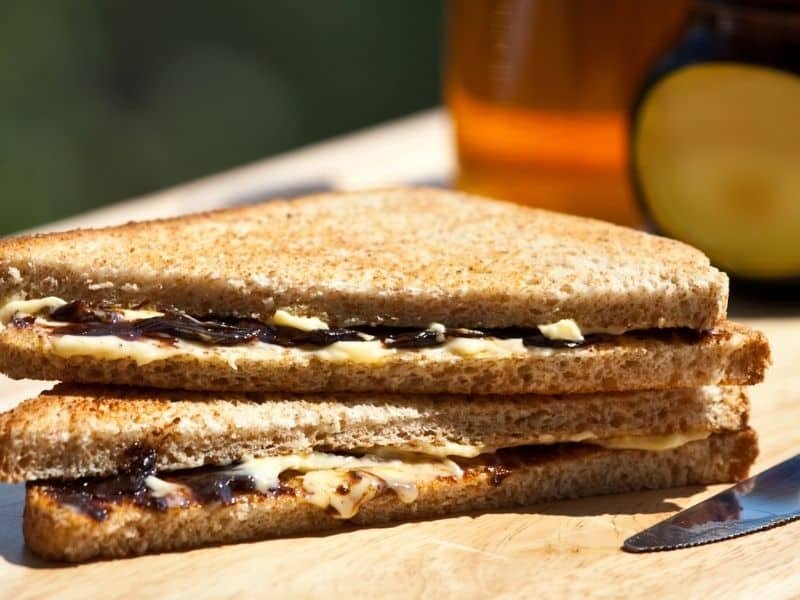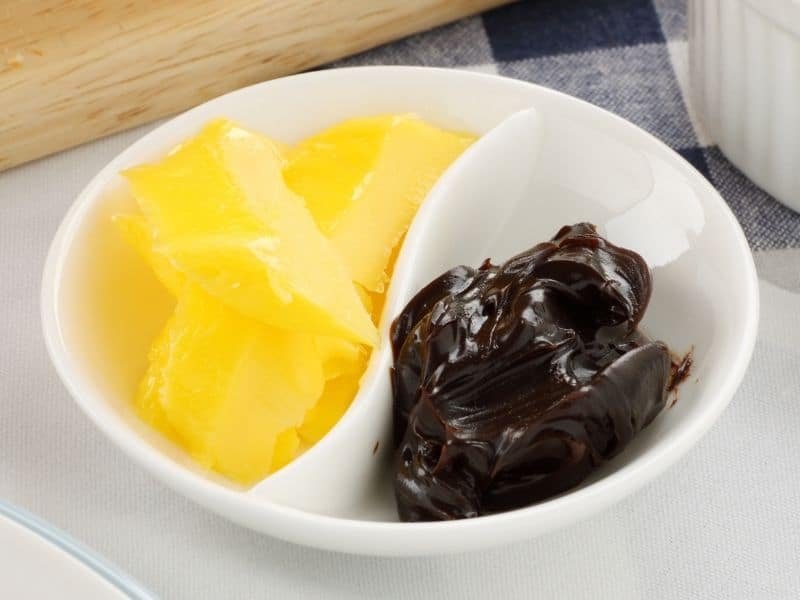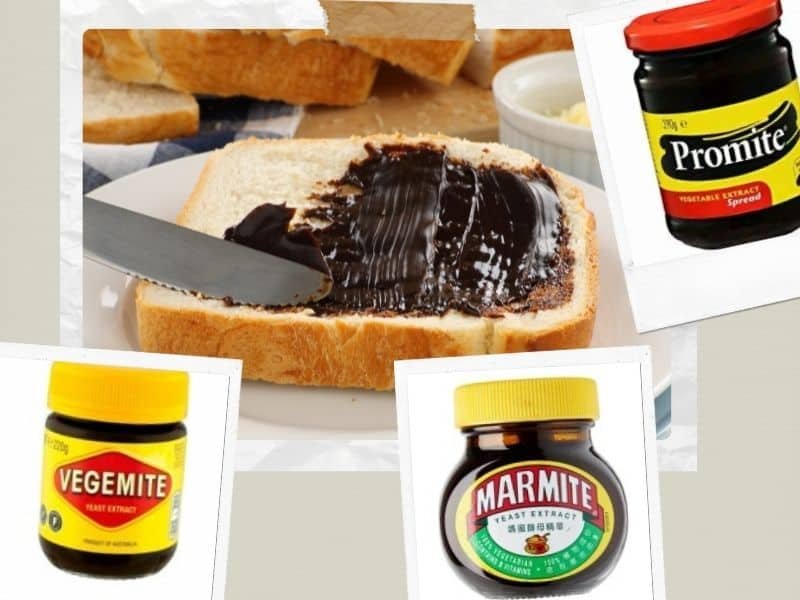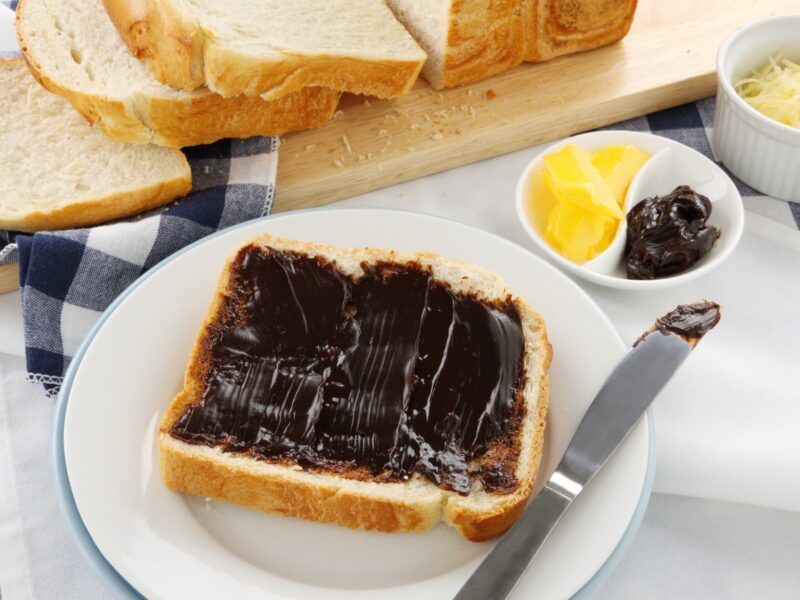
Do you love Vegemite, Marmite, or Promite? Or do you hate them all? What’s the difference? Which one is your favorite spread?
Vegemite vs. Marmite vs. Promite: So what’s the difference? Although similar, they are actually different in the making process, the ingredients, the taste, and the appearance.
This blog post will compare Vegemite, Marmite, and Promite and help you decide which one is your favorite yeast spread!
What You Need to Know About Vegemite

What is Vegemite?
Vegemite is an Australian spread. It is a salty spread, black paste that has a yeasty flavor. Vegemite is very popular in Australia, and it takes some getting used to.
In 1922, an Australian chemist named Cyril Callister created Vegemite, a yeast extract spread. It has been acquired over time and is now manufactured by Mondelez International.
Vegemite is most often eaten on white bread toast with butter, although it may also be used as a spread in sandwiches or pasta dishes.
It has been noted that many Australians will put Vegemite onto their scrambled eggs too.

What is Vegemite made of?
Vegemite is made from brewer’s yeast extractive, vegetable protein extract, malt extract, extract from barley, and spice additives. This Australian product has a characteristic flavor due to its origin in the brewing industry.
It is made from a by-product of beer, and yeast extract, and has been around for over 90 years.
How does it taste?
The flavor of Vegemite is rather intense. It’s salty because it’s high in salt. However, it has a strong flavor that might be likened to beef bouillon cubes or yeast extract.
The texture of this yeasty spread is similar to that of thick peanut butter. It’s a dark brown (almost black) paste with vitamin B content invented during World War I as a prime nutrient source.
It is vegan, kosher, and halal.
Nutrition Info
It has an effective Vitamin B content and significantly high amounts of folate, thiamin, riboflavin, and niacin.
A tablespoon of the spread contains about: 20 calories, 0g total fat, 320 mg sodium (about 17% daily value), 13 g carbohydrates, 12 g sugars, and 0 g dietary fiber.
There are also small amounts of calcium, iron, and vitamin C.
Flavors
Aside from Vegemite Original, Vegemite is available in various tastes, such as Vegemite Cheesybite, Vegemite Reduced Salt, and Blend 17. The nutrient profiles of these various kinds are also different.
Now a Gluten-Free option is also available for Vegemite! It’s the same fantastic flavor you know and love (if not milder taste), only gluten-free and FODMAP friendly.
What You Need to Know About Marmite

What is Marmite?
Marmite is a brown color yeast extract spread invented by German chemist Justus von Liebig and initially produced in the United Kingdom.
It’s a by-product of beer brewing produced by Unilever, a British firm.
Marmite is most commonly eaten on toast with butter but can also be used as a spread in sandwiches or sauces for pasta dishes.
Many people have mentioned that Marmite tastes delicious when spread onto crumpets.

What is Marmite made of?
Marmite is a yeast paste made from brewer’s yeast, a by-product of beer brewing. It’s suitable for vegetarians and vegans because it contains no animal products.
It contains added salt, sugar (taste enhancer), vegetable gum, Vitamin B, and some flavorings.
How does it taste?
Marmite is a salty-tasting, savory paste containing yeast extract that gives its distinct character. Some claim it has a beef bouillon-like flavor.
The most common way to eat this brown spread is on bread with butter or as part of a sandwich.
Marmite is commonly used as a flavor enhancer, as it is particularly rich in umami due to its very high levels of glutamate.
Nutrition Info
Marmite is the source of vitamins B1, vitamin B2, vitamin B3, Vitamins B6, vitamin B12, and folic acid, which can aid digestion and strengthen your immune system.
Flavors
Marmite comes in many different flavors. The original version is light, Marmite XO (super strong blend), and extra dark. Marmite Lite has less sugar and no artificial colors or flavorings added to the recipe.
For thickening, it is made from vegetable extracts, such as celery extract and onion extracts.
What You Need to Know About Promite

What is Promite?
Promite is a dark brown, salty food paste typically put on bread and toast in the same way as Vegemite Marmite.
The company was founded in the 1950s by Henry Lewis & Company and sold its products under the Masterfoods brand.
The company was renamed Masterfoods Australia and New Zealand before being acquired by the Mars family’s group of enterprises in 1967.
Promite is no longer an Australian-owned food, as Mars Incorporated is a privately-owned United States firm. However, Promite is still produced and sold in Australia today.

What is Promite made of?
Promite is made from vegetables and yeast extract and is naturally high in various B vitamins.
How does it taste?
Promite has a smooth texture with a unique taste. The taste is slightly sweeter than other yeast spreads. This spread is an excellent source of B Vitamins.
Promite is a tasty spread on toast or bread that comes in two handy sizes. It may also add flavor to soups, casseroles, and gravy.
Spread the paste on toast or fresh bread. It is also great on toasted crumpets, English muffins, or Pita bread.
Nutrition Info
According to Mars Customer care, “In 2013, we removed vitamins Thiamin (B1), Riboflavin (B2) and Niacin (B3), as well as two flavor enhancers, and found this to benefit some consumers sensitive to those vitamins, without impacting taste or texture”.
However, some natural vitamins remain from the raw ingredients, approximately:
- Thiamin B1 4mg / 100g
- Riboflavin B2 1mg / 100g
- Niacin B3 50mg / 100g
- Pantothenic Acid B5 12mg / 100g
- Vitamin B6 B6 3mg / 100g
Vegemite vs. Marmite vs. Promite: What’s the Difference?

When you compare Vegemite vs. Marmites vs. Promite, here are the differences between the black spreads.
The Making Process
Vegemite is made from brewer’s yeast extractive, vegetable extract, malt extract, extract from barley, and spice additives.
Marmite is a yeast paste made from brewer’s yeast, a by-product of beer brewing. It contains added salt, sugar (taste enhancer), vegetable gum, Vitamin B, and flavorings.
Promite is made from vegetables and yeast extract and is naturally high in various B vitamins. It contains additional sugar and glucose syrup in its ingredients.
The taste
Vegemite is much stronger than Marmite due to its richer and distinct flavor. However, vegemite has a salty, bitter taste, partly due to the high glutamates content, which gives it an umami flavor similar to beef bouillon.
Marmite is a sticky, thick paste with a distinctive salty, robust flavor. As the slogan says, “Love it or hate it.” However, its taste is still considered milder compared to Vegemite.
One other key difference between Vegemite and Marmite is that Marmite contains added sugar (taste enhancer).
Promite is sweeter than Vegemite. However, it is still slightly sweeter than Marmite.
The appearance
The first thing you notice about Vegemite and Promite is that they are jet black, with a thick texture comparable to other pastes like peanut butter.
Marmite has a deeper brown color and thicker syrup consistency, akin to honey, molasses, or melted chocolate.
The Ingredients
Although Vegemite and Promite look and taste quite similar, there are differences in their ingredients.
Promite contains more sugar than Vegemite. Vegemite has 2.2g of sugar per 100g, while Promite has 18g of sugar per 100g.
Promite lists both sugar and glucose syrup in its ingredients. In Vegemite, the sweetness comes from malt extract, which is the same grain-based sweetener used in brewing beer.

FAQs
Which came first, Vegemite or Promite?
Vegemite came first in the 1920s, while Promite was invented in the 1950s.
Is Vegemite better than Marmite?
Yes! Vegemite is tastier and healthier than Marmite.
Is Promite a Marmite?
No, Promite is not a Marmite clone.
Is Vegemite or Marmite older?
Marmite is older than Vegemite. While Marmite was created in the 19th Century by von Liebig, Vegemite was developed in Melbourne in the early 1920s by Cyril Percy Callister.










